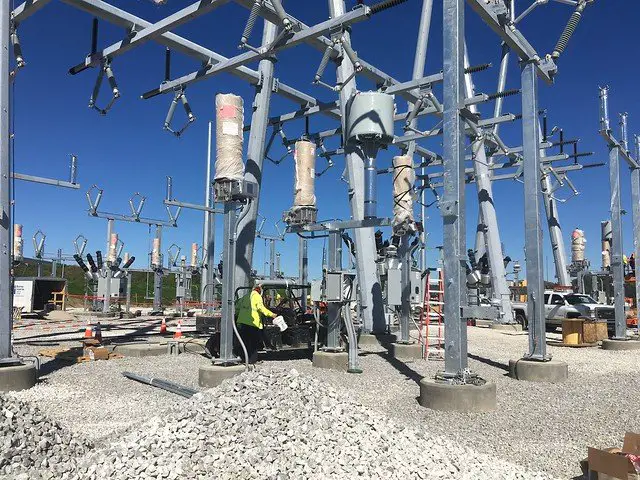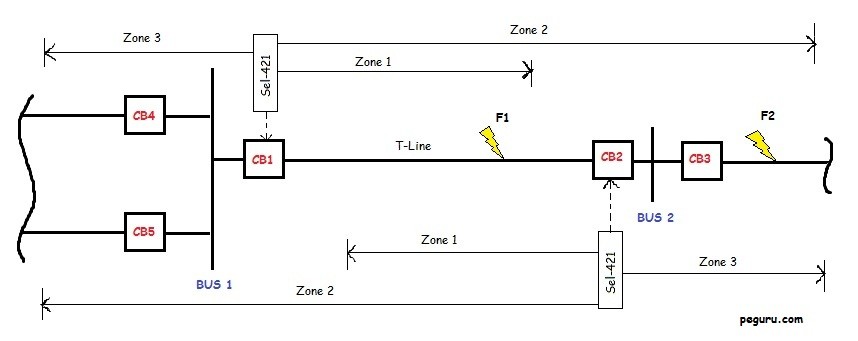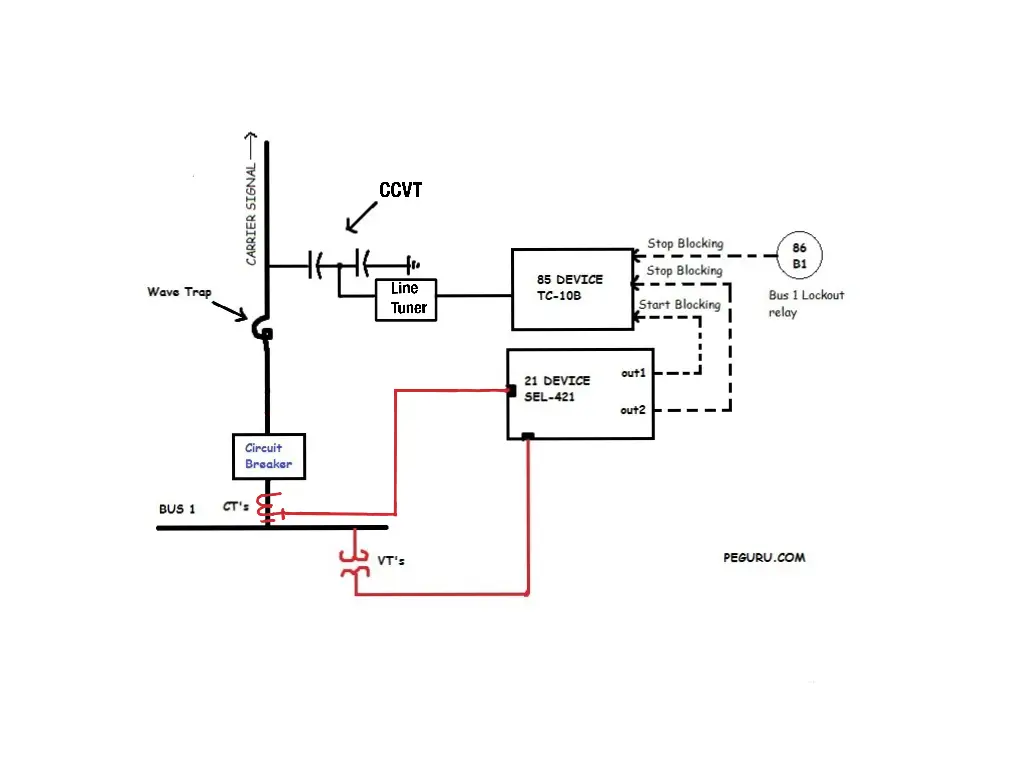- Online Training
- Access Your Courses
- Group Registration
- The Complete Relay Testing Handbook Series
- Book Extras
- Your Digital Downloads
- Hands-On Training Class Information
- Download Our Relay Training Brochure
- TechTalk (Our Blog)
- Add Your Post to TechTalk
- We Need Your Help!
- Why Choose Valence?
- About Chris Werstiuk
- Testimonials
- Contact Valence
- Subscribe to our Mailing List
- Your Shopping Cart
- The Relay Testing Handbook
- Your Account Info
No products in the cart.

Direct Transfer Trip and Direct Under-Reaching Transfer Trip Schemes Video
We’re continuing our end-to-end testing series by looking at the two simplest communication-assisted trip schemes used. Watch this Direct Transfer Trip and Direct Under-Reaching Transfer Trip Schemes Video to learn more about these two schemes. You can read the transcript below the video.
If you haven’t watched Understanding Line Distance protection (21) , watch it first.
Direct Transfer Trip and Direct Under-Reaching Transfer Trip Schemes Video Transcript
Welcome to the third video in our End-to-End Testing series. In this video we’re going to look at Direct Transfer Trip schemes or DTT schemes and then we’re going to look at Direct Under-Reaching Transfer Trip schemes (or DUTTs).
This video is part of a series. If you have not watched Understanding Line Distance Protection, the link is on the screen right now, then go watch that video first, so you get the foundation of what we’re going to talk about in this video so we don’t have to keep repeating ourselves over and over again. Let’s get started.
The first thing that we want to look at is the DTT, or the Direct Transfer Trip scheme and we don’t have a fancy animation built for that one because it’s really simple. What you’re looking at is an excerpt from The Relay Testing Handbook: End-to-End Testing and a DTT scheme is really just sending a signal from one side to the other. That’s what the direct part of Direct Transfer Trip stands for.
There is no reason for you to pull out your fancy GPS test equipment in order to test this scheme. The testing procedure for this scheme is very simple. Put one body at Relay 1, another body at Relay 2, get on your cell phones, and have Person 1 push the Trip button. The Trip button will go to the transmit of Relay 1. It’ll then send a signal to Relay 2. Relay 2 will receive that signal and open the breaker. Body Number 2 pushes their button and then the reverse should happen and Breaker Number 1 should open. Now it doesn’t have to be a trip contact. It could also be a breaker status contact or anything else, but it usually is something very simple. So there’s no reason for fancy test equipment.
The next scheme that we want to look at is the Direct Under-Reaching Transfer Trip and just like the Direct Transfer Trip scheme, Direct means that there’s no communication happening between the two relays. One relay sends the command to the other relay. So once again, there’s no reason for you to get out all your fancy GPS test equipment, because it’s a really simple test.
The top shows the standard distance protection scheme with no communication and the bottom shows the DUTT scheme with communication so that we can see what we’re gaining when we have the communication assisted trip schemes. And the first thing I’m going to do is, I’m going to put the fault really close to Relay 1. Now if you’ve watched the previous videos, or if you have any understanding of Distance Protection at all, you will know immediately that Relay 1 is going to see Zone 1 and it’s going to see Zone 2. Relay 2, because the fault is still on the line is going to see Zone 2. The difference between the standard distance scheme and the DUTT scheme is that the standard scheme Relay 1 is going to operate instantaneously and Relay 2 is going to operate after a 20 cycle delay, but if you look at the DUTT scheme, Zone 1 still trips the Relay 1 breaker immediately, but it also sends a command to the other side telling it to open as fast as it can, which is typically under 3 cycles, depending on communication delays. The DUTT scheme has saved us 17 cycles.
Now if I move the fault to the other side, you can see that the fault is now close to Relay 2 and the opposite is going to happen. Relay 2 is going to see Zone 1 and Zone 2. Relay 1 is going to see Zone 2 and the breaker connected to Relay 2 is going to open instantaneously and then we’re going to have that 17 cycle delay between the opening of the breaker on Relay 1.
If I go outside of the zone, this relay is going to see Zone 3 and Relay 2 is going to see Zone 2. Zone 2 has a faster time delay than Zone 3, so the Zone 2s are going to operate in the same amount of time. So the DUTT scheme gives us the benefit of saving 17 cycles for faults on the line and then giving us our normal backup protection for faults outside of the line. That 17 cycles might not seem like a big deal, but it is forever in electrical terms and there have been some papers presented that show that the longer a fault stays on the system, the more unstable it gets which is a big deal today.
If you like this animation, and you want to play with it some more, you can click the link below to go to our website and you can play with this animation or all the other ones that we’ve created for the communication trip schemes. I hope you’ve enjoyed this video. If you did, please subscribe to our channel, like, and also look for our next video, which should be about, Permissive Under-Reaching Transfer Trip schemes or PUTT schemes. We look forward to seeing you then, thank you.
Did you like this post?
You can share it with these links:
About the Author
Valence Announcements
Chris is an Electrical Engineering Technologist, a Journeyman Power System Electrician, and a Professional Engineer. He is also the Author of The Relay Testing Handbook series and founder of Valence Electrical Training Services. You can find out more about Chris here .
Read More Articles:
Valence will be at the NETA PowerTest 2016 Conference in Fort Worth, TN
I Want to Know How a High Impedance Differential Scheme Works
Leave a Reply
Your email address will not be published. Required fields are marked *
Substation Protection
- Reference work entry
- First Online: 21 July 2018
- Cite this reference work entry

- Richard Adams 4
Part of the book series: CIGRE Green Books ((CIGREGB))
2460 Accesses
The role of protection is not to prevent a fault from occurring but deal with it if one occurs and protect the power network as well as the primary equipment. Protection should detect and isolate the faulty equipment as quickly as possible in order to:
Minimize the risk of instability in the system including generators
Minimize damage to the faulty item of equipment
Minimize risk of damage to adjacent healthy equipment
This is a preview of subscription content, log in via an institution to check access.
Access this chapter
- Available as PDF
- Read on any device
- Instant download
- Own it forever
- Available as EPUB and PDF
- Durable hardcover edition
- Dispatched in 3 to 5 business days
- Free shipping worldwide - see info
Tax calculation will be finalised at checkout
Purchases are for personal use only
Institutional subscriptions
The following are not specifically referred in the previous section, nor meant to be an exhaustive list, but rather a possible source of further, more detailed information should the reader be interested. The E-CIGRE website is a very useful source of information published by the Study Committees of CIGRE
Google Scholar
Baxter, H.W.: Electric Fuses. Edward Arnold, London (1950)
Electricity Training Association: Power System Protection 4 Volume Set. The Institution of Engineering and Technology, London (1995). ISBN: 978-0-85296-847-5
Wright, A., Newberry, P.G.: Electric Fuses, 3rd Edition. The Institution of Engineering and Technology, London (2004). ISBN: 978-0-86341-399-5
Book Google Scholar
CIGRE Publications
TB 359 – Modern Distance Protection Functions and Applications, 2008
TB 431 – Modern Techniques for Protecting Busbars in HV Networks, 2010
TB 432 – Protection Relay Coordination, 2010
TB 463 – Modern Techniques for Protecting, controlling and monitoring power transformers, 2011
TB 465 – Modern Techniques for Protecting and Monitoring of Transmission Lines, 2011
TB 546 – Protection, Monitoring and Control of Shunt Reactors, 2013
TB 587 – Short Circuit Protection of Circuits with Mixed Conductor Technologies in Transmission Networks, 2014
TB 629 – Coordination of Protection and Automation for Future Networks, 2015
Download references
Author information
Authors and affiliations.
Power Systems, Ramboll, Newcastle upon Tyne, UK
Richard Adams
You can also search for this author in PubMed Google Scholar
Corresponding author
Correspondence to Richard Adams .
Editor information
Editors and affiliations.
CIGRE Study Committee B3, Power Network Consulting Pty Ltd, Adelaide, Australia
Terry Krieg
Siemens Transmission and Distribution, Manchester, UK
Rights and permissions
Reprints and permissions
Copyright information
© 2019 Springer International Publishing AG, part of Springer Nature
About this entry
Cite this entry.
Adams, R. (2019). Substation Protection. In: Krieg, T., Finn, J. (eds) Substations. CIGRE Green Books. Springer, Cham. https://doi.org/10.1007/978-3-319-49574-3_32
Download citation
DOI : https://doi.org/10.1007/978-3-319-49574-3_32
Published : 21 July 2018
Publisher Name : Springer, Cham
Print ISBN : 978-3-319-49573-6
Online ISBN : 978-3-319-49574-3
eBook Packages : Engineering Reference Module Computer Science and Engineering
Share this entry
Anyone you share the following link with will be able to read this content:
Sorry, a shareable link is not currently available for this article.
Provided by the Springer Nature SharedIt content-sharing initiative
- Publish with us
Policies and ethics
- Find a journal
- Track your research

Direct Transfer Trip (DTT) leveraging redundant cellular communication channels
Ieee account.
- Change Username/Password
- Update Address
Purchase Details
- Payment Options
- Order History
- View Purchased Documents
Profile Information
- Communications Preferences
- Profession and Education
- Technical Interests
- US & Canada: +1 800 678 4333
- Worldwide: +1 732 981 0060
- Contact & Support
- About IEEE Xplore
- Accessibility
- Terms of Use
- Nondiscrimination Policy
- Privacy & Opting Out of Cookies
A not-for-profit organization, IEEE is the world's largest technical professional organization dedicated to advancing technology for the benefit of humanity. © Copyright 2024 IEEE - All rights reserved. Use of this web site signifies your agreement to the terms and conditions.

Substation Design | Power System Analysis
Directional Comparison Blocking Scheme

The Directional Comparison Blocking (DCB) scheme is the most popular pilot relaying scheme, implemented to protect high voltage power lines. This scheme is more dependable than a permissive overreaching transfer trip scheme because it trips the breaker even when there is no carrier signal from the remote end pilot relay. Let’s dive into details.
Equipment Needed for Directional Comparison Blocking Scheme
Implementation of directional comparison blocking scheme, advantage of directional comparison blocking scheme.
- Distance relay like the Schweitzer 421 .
- Pilot relays like Pulsar TC-10B or Ametek’s UPLC-II . They generate carrier frequency.
- Hybrids – either balanced (resistive or reactive) or unbalanced a.k.a. skewed. Hybrids multiplex multiple signals (Tx/Rx) from the carrier equipment onto a single coax wire while minimizing signal distortion.
- Line tuner. It’s a band pass filter. It permits the passage of carrier frequency from the pilot relay on to the transmission line. It also contains an impedance matching transformer so that the carrier signal on a 50ohm coax wire does not reflect due to a transmission line with ~400ohm characteristic impedance.
- Capacitor Coupled Voltage Transformer . This device too provides a path for the carrier frequency, onto the transmission line. The capacitor in this device, combined with the inductance inside the line tuner, creates an RLC resonant circuit. The resonant frequency selected is the same as the carrier frequency.
- Wavetrap . It’s a band stop or notch filter (made of capacitor and inductor). It limits the carrier signals to the intended line section and prevents its propagation into the substation. Imagine it as a wall that blocks the carrier frequency.
High-speed tripping logic for DCB = Fault in Zone 1 OR Fault in Zone 2 AND no blocking signal received (from zone 3).
Let’s examine the DCB scheme using the figure below and its scenarios.

Fault @ F1 on T-line: This fault is internal to the circuit breakers CB1 and CB2. These breakers are the closest to the fault, and tripping them will isolate the fault. In this scenario, CB1 and CB2 trip without delay, by SEL-421.
Fault @ F2 on T-line: This fault is external to CB1 and CB2 but internal to CB3 and its remote end breaker(s). Since (time-delayed) zone 2 protective element on the CB1 relay can trip on it, it should be blocked. The intent is to trip the breakers local to the fault rather than taking out a larger portion of the system.
Thus, while CB3 takes measures to isolate the fault, CB2’s zone 3 element (looking backward) detects this fault as external and keys a “block from tripping” signal to CB1.
Do note that this blocking is not perpetual. The SEL-421 at CB1 is on a time-delayed logic and will eventually trip CB1, thus providing backup to CB3 when it fails to operate.
Fault @ Bus1 CB’s 1, 4, and 5 should trip to isolate the fault on Bus 1. A bus differential relay executes this job via a 86 lockout device. Contact from this 86 relay is also used to engage the 85 device – to key the block signal to remote-end (to stop CB2 from tripping on zone 2). Ofcourse, zone 3 element from CB1 relay transmits the block signal as well. See figure 2 for the oneline implementation of this scheme.

The above setup is quite simplified with only one device transmitting the carrier frequency. In practice, you could have 2 devices transmitting or 1-transmitting & 1-receiving or 2-receiving, etc. If you wish to multiplex multiple signals onto a single coax wire then you will need something called the hybrids. Furthermore, there is a very specific way to tie the hybrids (in order to decrease the signal-loss). It is beyond the scope of this article to explain this, however, read this resource (specifically page 27) that goes in great detail.
The distance protection using the DCB scheme is typically used as the first line of defense, especially when the comm channel is the power line carrier. The backup scheme tends to be either POTT or DCUB.
DCB is a dependable scheme because in the event the communication channel gets disrupted, the relays do not sit idle, waiting on the carrier signal. It only needs the channel to transmit a block signal for external faults.
On the flip-side, you wouldn’t know the channel has issues until the system gets activated or gets tested. To check the integrity, a test signal a.k.a. checkback is transmitted 3 or 4 times a day.
This article, part of a series, covers the essentials on pilot relaying and pilot protection schemes. If not done already, start at the beginning.
- Basics of Pilot Relaying & Application Considerations For Transmission Line Protection
- Directional Comparison Blocking Scheme (DCB)
- Permissive Overreaching Transfer Trip Scheme (POTT)
- Directional Comparison Un-Blocking Scheme (DCUB)
- Direct Transfer Trip Scheme (DTT) (This is technically not a pilot scheme but requires a pilot channel)
5 thoughts on “Directional Comparison Blocking Scheme”
Any disadvantage(s) for DCB?
I am sorry I assumed that zone 2 under DCB is the same as zone 2 under distance protection , now everything makes sense . Thank you !!!
CB 1 has zone 2
I have two questions for fault F2 on line , why are we blocking the tripping of CB1 , as CB 1 has zone and fault f2 , occurs on zone 1 for CB 3 , CB 3 will go out faster anyways than CB 1 , so why are we doing that ? Second , if should CB3 fails to operate you want CB2 to operate first the breaker nearest to CB 3 , now that being said , it then indeed makes sense to block CB 1 from tripping beacuse , if CB 3 fails CB2 will operate and clear the fault , and CB 1 will be blocked from tripping under zone 2 . So that is my main point of confusion .
Thanks for these information. Finally able to kill my confusions.
Leave a Comment Cancel Reply
Your email address will not be published. Required fields are marked *
Aleen Mohammed
Connect with me
- NBA Blue Devils
- FanNation FanNation FanNation
- SI.COM SI.COM SI.COM
- SI Swimsuit SI Swimsuit SI Swimsuit
- SI Sportsbook SI Sportsbook SI Sportsbook
- SI Tickets SI Tickets SI Tickets
- SI Showcase SI Showcase SI Showcase
- SI Resorts SI Resorts SI Resorts
- NEWSLETTER NEWSLETTER NEWSLETTER

© Rob Gray-USA TODAY Sports
Duke Basketball: Top Sharpshooter No Longer Slated for Trip to Durham
The reigning champs look like the clear favorite for Duke basketball transfer target Koby Brea.
- Author: Matt Giles
In this story:
Former four-year Dayton guard Koby Brea, a two-time Atlantic 10 Sixth Man of the Year and the NCAA's 2023-24 leader in 3-point percentage at 49.8 on 201 attempts, initially planned to arrive in Durham on Tuesday for a three-day Duke basketball visit, college hoops insider Adam Zagoria reported on Friday morning.
RELATED: Reported Duke Transfer Interest Removes Name From Portal
But in this new transfer era, plans often get torn to shreds in a flash during the heart of portal season. A frontrunner will quickly emerge with precisely what the transfer is looking for, snagging a visit and ensuing commitment.
On that note, it now appears that defending back-to-back national champion UConn is the perceived outright frontrunner for the 21-year-old Brea, who arrived in Storrs on Friday for a visit with Huskies head coach Dan Hurley and his staff extending through Sunday.
And as The News & Observer's Steve Wiseman first reported on Friday afternoon, the aforementioned planned visit to Duke is suddenly no longer on Brea's calendar.
Can report that Dayton transfer guard Koby Brea is not visiting Duke next week. It had been discussed and planned but is now off. The Blue Devils do need another veteran guard but it doesn't look like it will be Brea, whose strength is more as a shooter than a ballhandler. — Stephen Wiseman (@stevewisemanNC) April 26, 2024
Hours later, the 247Sports Crystal Ball received its first prediction in the Koby Brea sweepstakes. No surprise it points to UConn as the favorite over fellow blueblood finalists Duke, Kentucky, UNC, and Kansas.
Meanwhile, it appears as though Duke basketball's search for backcourt depth via the transfer portal may well extend for another couple of weeks. As of the canceled visit between Brea and the Blue Devils, there are currently no reported transfer prospects on tap for Jon Scheyer and his staff to host as they try to add to their two portal pickups thus far in forwards Mason Gillis and Maliq Brown.
RELATED: Electrifying Transfer Guard Hears From Duke Coaches
It's also worth noting, though, that players have until Wednesday to enter their name into the transfer portal. So, it's possible the ideal perimeter addition (or two) for the 2024-25 Duke roster hasn't officially made himself available to be recruited just yet.
Stay tuned to Blue Devil Country on SI for more Duke basketball news.
Latest Blue Devils News

Duke Product Grayson Allen Goes Off Against 76ers

2024 NCAA Tournament: Predicting 5 March Madness Stock Risers

Vegas gives Duke better odds to win the South Region than Kentucky

Future Duke Center May Face Several Blue Devils in Olympics

Duke Legend Undertakes Fun Project Alongside LeBron James

IMAGES
VIDEO
COMMENTS
Direct Transfer Trip Scheme. Direct Transfer Trips (DTT) are initiated from station relays when a severe event occurs in the substation. Some of these events are breaker failure, bus faults, transformer failure, etc. A lockout relay (86 device) is assigned to each event. The lockout relay in the station is pretty essential.
Fig. 3. (Point of Circuit Connection "PCC" Direct Transfer Trip logic) From Fig. 3 the PCC-DTT initiate a DTT trip on the receipt of a DTT "GOOSE" from the either the delivery point substation or the distribution substation in addition if a communication failure is detected at any of the DTT devices. A reverse power
Fig. 3. (Point of Circuit Connection "PCC" Direct Transfer Trip logic) From Fig. 3 the PCC-DTT initiate a DTT trip on the receipt of a DTT "GOOSE" from the either the delivery point substation or the distribution substation in addition if a communication failure is detected at any of the DTT devices.
Direct Transfer Trip (DTT) signals, traditionally sent between substations and remote DG sites using leased telephone lines. Due to the highly specialized and critical nature of DTT systems, the equipment, including the communication infrastructure, must be extremely reliable and conform to highest substation standards.
Temporary loss of communication. Provide Anomaly Detection Protection. Provide true redundant communication capability. Provide Event and Fault Reports to operators. All DTT devices aware of all feeder circuit primary switch statuses. Ensure system is interoperable and future proof. IEC61850 Standard.
Transfer-trip method Equipping the utility substation and DG interconnection with automation and external communication systems ensures a reliable, safe and a cost effective solution. The utility can be assured that they will always have a method for disconnecting interconnected generation (transfer-trip) in the event
The next scheme that we want to look at is the Direct Under-Reaching Transfer Trip and just like the Direct Transfer Trip scheme, Direct means that there's no communication happening between the two relays. One relay sends the command to the other relay. So once again, there's no reason for you to get out all your fancy GPS test equipment ...
Direct transfer trip (DTT) - The zone 1 element of the relay at one end initiates tripping of the local CB and also sends a signal to the other end to initiate a trip, ... At busbar substations, it is common to use the busbar tripping system to effect the CBF trip, since this already has tripping connections to all of the other circuits. ...
An analysis of a permissive overreaching transfer trip scheme at a 120kV substation Abstract: This paper describes a post fault investigation into an undesired operation of a protective device in a permissive overreaching transfer tripping scheme at a 120 kV substation. The paper includes a system description, an event analysis, and a proposed ...
PLCC in modern electrical power system substation is mainly used for following purpose: ... When tuning the power line tuner with a blocking carrier transceiver frequency and a receive only transfer trip frequency is it necessary to tune to the GMF or is tuning to the blocking carrier frequency the way to tune. Reply. anjali bharti. Feb 12, 2018.
The transfer trip signal requires local confirmation by this fault detector before tripping can occur. This increases the security of the scheme and the consequent range of application. ... Design Guide for Rural Substations by United States Department of Agriculture; Related electrical guides & articles. Mastering stability test of power ...
on its respective function. The substation unit is required to transfer trip signals from the Utility Substation, the downstream control unit is needed to repeat the Substation trip signal to each DG site, and the DG site control device is needed to receive the trip signal from the substation and initiate the disconnect of the local breaker.
Tripping of the transformer is accomplished by sending a transfer trip signal to the remote substation using a communications signal or a high-speed ground switch. The time required to isolate the transformer is increased by the communication channel time or the time for the remote relay and breaker to clear the fault established by the high ...
This is achieved via Direct Transfer Trip (DTT) signals, traditionally sent between substations and remote DG sites using leased telephone lines. Due to the highly specialized and critical nature of DTT systems, the equipment, including the communication infrastructure, must be extremely reliable and conform to highest substation standards.
world's first operating substation compliant with the standard IEC 61850 [8]. So far, IEC 61850 has been implemented in new substation projects and substation upgrades to communicate with IEDs inside the substation. This thesis compares the performance of a Permissive Overreach Transfer Trip (POTT)
In high voltage grid substations or generating stations during maintanence of circuit breaker, load of that bay may be diverted to Transfer Bus Coupler(TBC)....
August 15, 2023. Office of NEPA Policy and Compliance. CX-028683: Colville and Addy Substation Transfer Trip Upgrade Project. Bonneville Power Administration (BPA) proposes to replace aging transfer trip equipment at its Colville and Addy substations.
Substations usually include a ground mat. A ground mat is a system of bare conductors, on or below the surface, connected to a ground to provide protection from high voltages. Purpose of Substations. One purpose of a substation is to contain the equipment for changing electric energy from one voltage to another.
The Directional Comparison Blocking (DCB) scheme is the most popular pilot relaying scheme, implemented to protect high voltage power lines. This scheme is more dependable than a permissive transfer trip scheme because it trips the breaker even when there is no carrier signal from the remote end pilot relay. Let's dive into details.
1. Substation classification. Substations can be generally divided into three major types (according to voltage levels): 1.1 Transmission substations. Transmission substations integrate transmission lines into a network with multiple parallel interconnections, so that power can flow freely over long distances from any generator to any consumer.
Transfer Trip: During Phase I, the Xxxx Substation is connected via a tap to the MWP-2 line. Breaker failure protection (primary and alternate) relays and Direct Transfer Trip ("DTT") transmit/receive capability to/from Valley & Inghams Station's remote breakers via carrier and audio-tone, including telephone circuit, DTT receive relays ...
Former four-year Dayton guard Koby Brea, a two-time Atlantic 10 Sixth Man of the Year and the NCAA's 2023-24 leader in 3-point percentage at 49.8 on 201 attempts, initially planned to arrive in ...
Tesla's CEO Elon Musk visited Beijing on Sunday and hoped to convince senior Chinese officials to greenlight the electric-vehicle's Full Self-Driving feature in China.